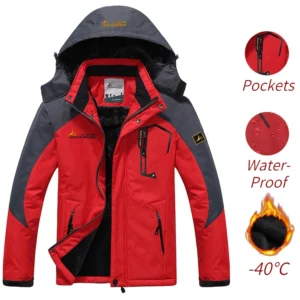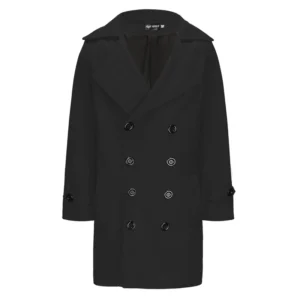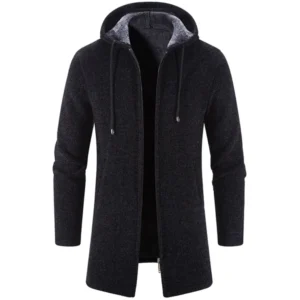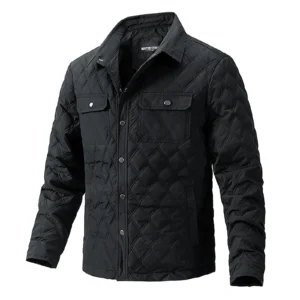The Science of Wool’s Winter Warmth
Yes, wool coats are excellent for keeping you warm in winter due to their natural insulating properties. The science behind wool’s exceptional warmth lies in its unique fiber structure and inherent characteristics that have made it a trusted winter material for centuries.
Wool fibers have a remarkable natural structure that creates superior insulation. Each strand features a crimped, wavy pattern and is covered with microscopic scales. These characteristics create thousands of tiny air pockets that trap your body heat close to you, forming a natural barrier against cold temperatures. This is the same principle that helps sheep stay warm in harsh mountain environments.
What truly sets wool apart is its impressive moisture management:
- Wool can absorb up to 30% of its weight in moisture without feeling wet
- The fibers wick moisture away from your body, preventing the clamminess often experienced with synthetic materials
- Unlike cotton, which loses insulating properties when wet, wool maintains approximately 80% of its insulating ability even when damp
Perhaps most impressive is wool’s natural thermoregulation ability. It both insulates and breathes simultaneously, helping maintain your body at a comfortable temperature. This explains why explorers in polar expeditions and high-altitude climbers have relied on wool garments for centuries.
Understanding the ultimate guide to wool car coats for men provides additional insights into how these scientific properties translate into practical winter warmth.
Types of Wool and Their Warming Properties
Not all wool is created equal when it comes to keeping you warm in winter. Different wool types offer varying levels of insulation, softness, and durability, which directly impacts a coat’s performance in cold weather.
Common Wool Types and Their Properties
| Wool Type | Fiber Diameter | Warmth Level | Special Properties |
|---|---|---|---|
| Merino | 15-24 microns | High | Ultra-soft, excellent temperature regulation, minimal itchiness |
| Cashmere | 14-19 microns | Very high | Exceptionally soft and lightweight, luxury insulation |
| Lambswool | 16-30 microns | Good to high | Soft, resilient, balances warmth and comfort |
| Alpaca | 20-30 microns | Very high | Warmer than sheep’s wool, hollow fibers, hypoallergenic |
| Shetland | 23-30 microns | High | Excellent wind resistance, durable, traditional |
Merino wool stands out for its versatility and comfort. Its fine fibers create dense insulation that works effectively across a wide temperature range (from 15°F to 80°F/-9°C to 27°C). This makes merino wool coats suitable for variable winter conditions and active lifestyles.
Cashmere, while technically not sheep’s wool but from the cashmere goat, offers extraordinary warmth despite its lightweight feel. This makes it ideal for elegant winter coats that don’t sacrifice insulation for style. However, its delicate nature means it often requires more care than sturdier wool types.
The difference between virgin wool and recycled wool also affects warmth. Virgin wool (from a sheep’s first shearing) typically provides superior insulation because the fibers are longer and stronger. Recycled wool, while environmentally friendly, may offer slightly reduced insulation due to shorter fibers resulting from the recycling process.
Many buyers wonder if 100 percent wool coats are best for winter, and the answer depends largely on which type of wool is used and how the garment is constructed.
Understanding Wool Content Percentage in Coats
The percentage of wool in your winter coat directly impacts its warming capability. Higher wool content generally means better insulation, but there are important nuances to consider when evaluating a coat’s composition.
Wool Percentage Guide
| Wool Content | Insulation Level | Best For | Common Blend Materials |
|---|---|---|---|
| 90-100% | Maximum | Severe cold, traditional styling | Minimal synthetic reinforcement |
| 70-89% | High | Cold conditions, everyday wear | Nylon, polyester for durability |
| 50-69% | Moderate | Mild winters, active lifestyles | Polyester, acrylic for stretch and cost |
| Below 50% | Basic | Transitional seasons, style-focused | Numerous synthetic fibers |
When examining coat labels, look beyond just the wool percentage. Manufacturers blend wool with other fibers for specific reasons:
- Nylon or polyester adds durability and can help the coat maintain its shape
- Acrylic improves resistance to moths and reduces cost
- Elastane or spandex introduces stretch for comfort and movement
- Cashmere may be added for increased softness without sacrificing warmth
A common misconception is that only 100% wool provides adequate warmth. In reality, high-quality wool blends with content above 70% can deliver excellent insulation while offering practical benefits like improved durability, reduced weight, and easier care. Many who research whether 70 percent wool coats provide adequate warmth find that these blends strike an excellent balance between insulation and practicality.
When shopping, always check the garment tag not just for wool percentage but also for what other materials are included, as this combination determines the coat’s overall performance in winter conditions.
Coat Construction Features That Enhance Warmth

While wool content is crucial, how a coat is constructed often makes the difference between feeling comfortably warm or still chilly in winter conditions. Several key construction elements work together to maximize the natural insulating properties of wool.
Fabric Weight and Density
The weight of wool fabric is measured in GSM (grams per square meter), with winter coats typically falling into these ranges:
* Lightweight: 300-400 GSM (suitable for mild winters or layering)
* Medium weight: 400-500 GSM (standard winter protection)
* Heavyweight: 500+ GSM (severe cold protection)
Denser weaves trap more warm air, so look for tightly woven fabrics. Common wool weaves for winter include:
* Melton: Dense, wind-resistant, excellent insulation
* Twill: Durable diagonal weave with good warmth
* Herringbone: Distinctive V-pattern that creates air pockets for insulation
Lining Construction
A quality lining dramatically enhances a wool coat’s warming ability:
* Quilted linings with thin insulation layers add significant warmth
* Flannel linings provide soft, cozy insulation
* Thinsulate™ or other technical linings offer maximum warmth with minimal bulk
* Full linings that extend through the sleeves prevent cold spots
Design Elements That Maximize Warmth
- Double-breasted designs create an overlapping front panel that essentially doubles the insulation across your chest, reducing heat loss by up to 25%
- High collars protect the vulnerable neck area, preventing up to 30% of potential body heat loss
- Storm flaps over zippers and buttons block wind penetration
- Longer lengths provide crucial protection for the lower body
- Adjustable cuffs and waistbands prevent warm air from escaping
The double-breasted pea coat design has remained popular for centuries specifically because its overlapping front panels create superior insulation against cold winds. This construction technique makes these coats particularly effective for winter wear.
Remember that even the highest quality wool will underperform if the coat construction allows cold air to penetrate or warm air to escape. When evaluating a winter coat, examine these construction details carefully, as they significantly impact the garment’s ability to keep you warm.
How Wool Compares to Other Winter Coat Materials
When choosing winter outerwear, it’s helpful to understand how wool stacks up against other popular materials. Each has distinct advantages and limitations when it comes to keeping you warm.
Comparative Performance of Winter Materials
| Material | Warmth-to-Weight | Performance When Wet | Wind Resistance | Durability | Breathability |
|---|---|---|---|---|---|
| Wool | Good | Excellent (retains 80% insulation) | Very good | Excellent | Excellent |
| Down | Excellent | Poor (clumps, loses insulation) | Poor (without shell) | Good | Good |
| Synthetic Fill | Good | Good (retains 50-70% insulation) | Poor (without shell) | Good | Moderate |
| Fleece | Moderate | Good | Poor | Moderate | Good |
Wool offers a unique combination of benefits that few other materials can match. Unlike down, which provides superior warmth in dry conditions but fails when wet, wool continues insulating effectively even in damp conditions. This makes wool particularly suitable for snowy or rainy winter climates.
Synthetic insulations like Thinsulate™ or PrimaLoft® have improved dramatically and offer good wet-weather performance, but they typically don’t breathe as well as wool. This can lead to overheating during activity or when moving between outdoor and indoor environments.
Cotton, while comfortable in many settings, is generally unsuitable for serious winter wear. When cotton gets wet (even from perspiration), it loses virtually all insulating properties and can actually accelerate body heat loss, making it potentially dangerous in cold conditions.
The superior longevity of wool deserves special mention. While quality down jackets or synthetic coats might last 3-5 years with regular use, a well-made wool coat can provide warmth for decades with proper care. This long-term performance is part of what makes wool coats excellent investment pieces.
For those curious about exactly how warm wool coats are in winter, it’s worth noting that wool’s natural properties allow it to adapt to a wide range of temperatures, making it one of the most versatile winter materials available.
Choosing the Right Wool Coat for Different Winter Climates
The ideal wool coat for someone in Boston will differ significantly from what works best in Seattle or Chicago. Understanding how to match coat characteristics to your specific climate ensures you stay comfortably warm without overheating.
Mild Winters (40-55°F/4-13°C)
For areas with milder winters like the Southern United States or Pacific Coast:
* Choose lightweight wool (300-400 GSM)
* Consider wool blends with 50-70% wool content
* Look for unlined or lightly lined styles
* Car coat or shorter styles often provide sufficient coverage
* Single-breasted designs are typically adequate
Moderate Winters (25-39°F/-4 to 4°C)
For areas with standard winter conditions like much of the Midwest and Northeast:
* Select medium-weight wool (400-500 GSM)
* Opt for higher wool content (70-90%)
* Ensure full lining, ideally with light insulation
* Mid-length styles provide good balance of coverage and mobility
* Consider double-breasted options for additional chest protection
Severe Winters (Below 25°F/-4°C)
For regions with harsh winters like the Upper Midwest, Mountain West, or Northern New England:
* Choose heavyweight wool (500+ GSM)
* Look for high wool percentage (90-100%) or premium wool types like merino
* Select fully insulated linings
* Longer coat styles that cover the thighs provide crucial protection
* Double-breasted construction with high collar is optimal
* Ensure close-fitting cuffs and waistband to prevent heat loss
Humidity levels also affect your choice. In damp, cold climates (like the Pacific Northwest), look for tightly woven wool with water-resistant treatments. In dry, windy areas (like the Great Plains), prioritize wind-resistance with densely woven fabrics like melton wool.
Exploring our collection of men’s wool coats can help you find options specifically designed for different climate conditions, ensuring you select the right coat for your region’s winter challenges.
Layering Strategies to Maximize Your Wool Coat’s Warmth
Even the warmest wool coat performs better with strategic layering. Understanding how to combine layers effectively can significantly enhance your comfort in cold conditions.
The key to effective winter layering lies in creating a system where each garment serves a specific purpose:
Base Layer: Managing Moisture
- Choose moisture-wicking fabrics that pull sweat away from your skin
- Merino wool, silk, or technical synthetic base layers work best
- Avoid cotton, which retains moisture and causes chilling
- Ensure a snug (but not tight) fit for maximum effectiveness
Mid Layer: Insulation
- This layer traps warm air close to your body
- Lightweight fleece, down vests, wool sweaters, or synthetic insulated pieces work well
- The thickness should correspond to the temperature (thicker for colder days)
- Maintain some mobility without excessive bulk
Wool Coat: Outer Protection
- Your wool coat serves as both insulation and a protective shell
- It blocks wind and provides the final insulating layer
- When sized correctly, it should allow room for layers without restriction
- Look for design features like adjustable cuffs to seal out cold air
When shopping for a wool coat intended for layering, consider sizing up slightly from your normal fit—approximately 1-2 inches of extra room ensures you can comfortably wear mid-layers without compromising movement or creating a compressed insulation layer, which reduces warmth.
The beauty of proper layering is adaptability. On milder days, you might skip the mid-layer. During severe cold, you can add a heavier mid-layer for additional insulation. This flexibility makes your wool coat more versatile across varying winter conditions.
For more detailed information, our ultimate guide to winter layering with wool car coats provides comprehensive strategies for maintaining optimal warmth in various conditions.
Essential Features to Look For When Purchasing a Wool Coat
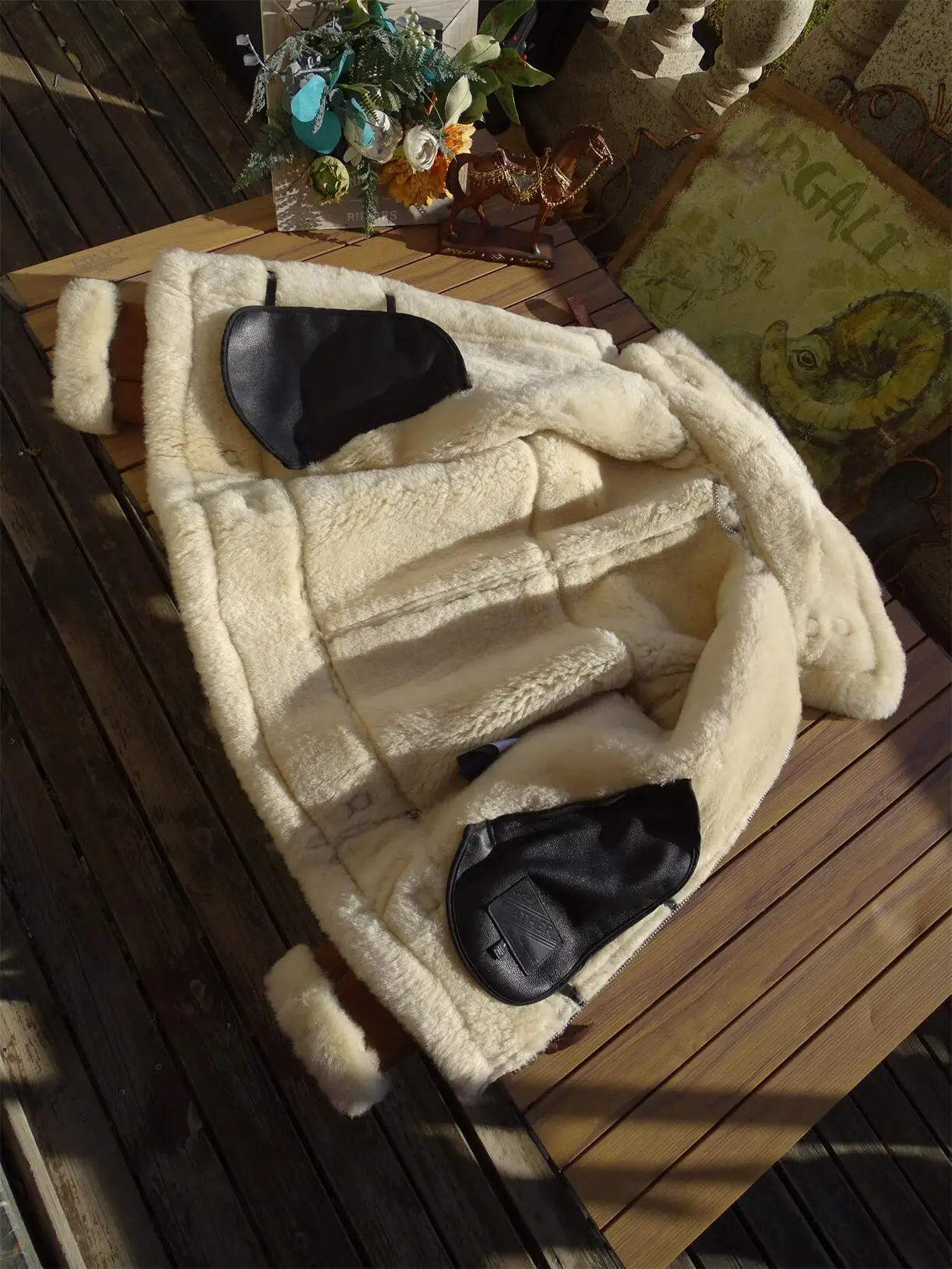
When investing in a wool coat for winter warmth, certain quality markers and features significantly impact both insulation performance and longevity. Use this checklist to ensure you’re selecting a coat that will truly keep you warm when temperatures drop.
Quality Indicators
- Weight: A quality wool coat should feel substantial when lifted
- Fabric density: Perform the “pinch test” by pinching the fabric—it should feel firm and dense, not loose or flimsy
- Even texture: Look for consistent coloring and texture throughout
- Clean finishing: Examine seams for straight, even stitching without loose threads
Critical Construction Details
- Tightly sewn seams with no gaps where cold air could penetrate
- Reinforced button attachments that won’t loosen over time
- Fully secured lining without puckering or loose areas
- Double-stitched stress points at shoulders and armholes
- Smooth, functional closures (buttons, zippers) that close completely
Fit Considerations for Maximum Warmth
- Shoulders should align with your natural shoulder line
- Sleeves should cover your wrists even when arms are extended
- Adequate room across chest and back for layering without strain
- Sufficient length to cover your seat (for standard wool coats) or mid-thigh (for overcoats)
- Collar should close comfortably at the neck without gaps
Premium Features Worth the Investment
- Wind guards beneath button plackets
- Interior ribbed cuffs for wind protection
- Throat latch for additional neck protection
- Water-resistant treatment for snow and light rain protection
- Reinforced pockets that won’t stretch out of shape
When evaluating cost versus features, remember that a higher-quality wool coat might cost more initially but can provide 5-10 years of reliable winter warmth with proper care. This long-term value often makes premium features worthwhile investments.
Our collection of men’s wool overcoats includes options with many of these essential features, ensuring both warmth and longevity for winter wear.
Care and Maintenance for Long-Lasting Warmth
Proper care ensures your wool coat maintains its warming properties for many winters. Following these maintenance guidelines preserves both the appearance and insulating performance of wool garments.
Regular Maintenance
- Brush your wool coat after each wearing with a soft-bristled clothing brush
- Brush in the direction of the nap using gentle, downward strokes
- Allow the coat to air out for at least 24 hours between wearings
- Use wooden or padded hangers that support the shoulders properly
- Avoid hanging on narrow or wire hangers that can distort the shape
Spot Cleaning
- Address spills immediately by blotting (never rubbing) with a clean cloth
- Use a damp cloth with mild soap for small stains
- Test any cleaning solution on an inconspicuous area first
- Avoid over-wetting the wool, as excessive moisture can damage the fibers
- Allow to air dry completely away from direct heat sources
Professional Cleaning
- Have your wool coat professionally dry cleaned once per season
- Clean before storage, as dirt and food particles can attract moths
- Provide specific information about any stains to your cleaner
- Request minimal pressing to avoid flattening the wool’s natural loft
Storage
- Clean thoroughly before storing for the off-season
- Use breathable garment bags, never plastic
- Add cedar blocks or lavender sachets to deter moths
- Store in a cool, dry place away from direct sunlight
- Avoid compression with heavy items that could flatten insulation
Common Mistakes to Avoid
- Never machine wash unless the coat is specifically labeled as machine washable
- Avoid direct heat for drying, which can cause shrinking and fiber damage
- Don’t use clothes pins or clips that can create permanent marks
- Avoid storing in damp basements or attics where mildew can develop
- Don’t ignore small repairs—fix loose buttons and small tears immediately
These care practices help maintain the loft and crimp of wool fibers, which are essential to the material’s insulating properties. With proper maintenance, our heavy winter coats can provide reliable warmth for many seasons.
Is a Wool Coat Warm Enough for Extreme Cold?
While wool coats provide excellent insulation for most winter conditions, they do have limitations in extreme cold. Understanding these boundaries helps set realistic expectations for wool’s performance.
Temperature Thresholds
Wool coats typically perform well in these temperature ranges:
* Standard wool overcoats: Comfortable to approximately 15-20°F (-9 to -6°C)
* Heavy wool coats with proper layering: Effective to about 0-10°F (-18 to -12°C)
* Below 0°F (-18°C): Additional protection usually needed
When temperatures drop below these thresholds, wind chill becomes a crucial factor. Even a heavy wool coat may be insufficient when strong winds create effective temperatures significantly below the actual air temperature.
Supplementing Wool in Extreme Conditions
For extreme cold protection, consider these additions:
* Merino wool scarf covering the lower face and neck
* Insulated gloves or mittens (hand extremities lose heat quickly)
* Thermal base layers under regular clothing
* Wool hat covering the ears (up to 30% of body heat can be lost through an uncovered head)
Mens Heavy Winter Coat, Mens Insulated Coat, Mens Parka Coat
Price range: $175.52 through $237.36 Select options This product has multiple variants. The options may be chosen on the product pageMens Double Breasted Pea Coat, Mens Wool Blend Coat, Mens Wool Pea Coat
Price range: $136.84 through $157.36 Select options This product has multiple variants. The options may be chosen on the product pageMens Cashmere Overcoat, Mens Hooded Winter Coat, Mens Wool Blend Coat
Price range: $128.72 through $139.68 Select options This product has multiple variants. The options may be chosen on the product pageMens Black Overcoat, Mens Black Wool Coat, Mens Wool Overcoat
$339.18 Select options This product has multiple variants. The options may be chosen on the product pageMens Double Breasted Pea Coat, Mens Hooded Winter Coat, Mens Quilted Coat
Price range: $81.00 through $108.48 Select options This product has multiple variants. The options may be chosen on the product pageMens Grey Overcoat, Mens Wool Blend Coat, Mens Wool Overcoat
$201.28 Select options This product has multiple variants. The options may be chosen on the product page
When to Consider Technical Outerwear Instead
Certain situations call for specialized winter gear rather than traditional wool:
* Extended outdoor activities in sub-zero temperatures
* Environments with extreme wind exposure
* Activities generating significant perspiration
* Areas with heavy, wet snowfall
Indigenous peoples in Arctic regions traditionally used fur rather than wool for the coldest conditions, indicating wool’s natural limitations in extreme environments. Modern technical outerwear with specialized insulation often draws on these traditional insights while incorporating advanced materials.
For those needing to understand varying levels of protection for different conditions, our ultimate guide to men’s coats warmth level provides detailed comparisons across different temperature ranges and activities.
Are Wool-Blend Coats Worth Considering?
Wool-blend coats offer practical alternatives to 100% wool options, with their own set of advantages and compromises. Understanding these differences helps determine whether a blend might better suit your specific needs.
Advantages of Wool Blends
- Enhanced Durability: Adding synthetic fibers like nylon or polyester can reduce pilling and improve abrasion resistance
- Reduced Weight: Blends are often lighter than pure wool while maintaining good insulation
- More Affordable: Typically priced 15-30% less than comparable 100% wool coats
- Easier Care: Many blends are machine washable or require less delicate handling
- Increased Flexibility: Addition of stretch fibers improves comfort for active movement
Warmth Trade-offs
Most high-quality wool blends maintain excellent insulating properties when:
* Wool content remains above 60-70%
* The weave is sufficiently dense
* The coat construction includes proper lining and design features
The most effective wool blends combine wool with complementary materials:
* Wool/cashmere blends offer exceptional softness while maintaining excellent insulation
* Wool/nylon blends provide improved durability without significant warmth reduction
* Wool/polyester blends with at least 70% wool content retain most thermal properties while adding weather resistance
For most everyday winter conditions in urban environments, a well-constructed wool blend coat with 70-80% wool content provides entirely adequate warmth while offering practical advantages in maintenance and durability.
Our selection of wool blend coats includes options that balance warmth with practical considerations, making them excellent choices for active lifestyles and varied winter conditions.
Modern Innovations in Wool Coat Technology
Traditional wool coats have evolved significantly in recent years, incorporating technological advances that enhance their performance without sacrificing classic appeal. These innovations address many of wool’s historical limitations while preserving its natural benefits.
Water-Resistant Treatments
Modern water-repellent finishes specifically designed for wool have dramatically improved its performance in wet conditions:
* Nanosphere technology creates a microscopic surface texture that causes water to bead and roll off
* These treatments maintain wool’s breathability while adding protection
* Unlike older treatments, new formulations preserve wool’s natural softness and drape
Technical Wool Developments
Advanced manufacturing processes have created new variations of wool fabric:
* Lighter weight wools (under 300 GSM) that maintain warmth through specialized weaving techniques
* Three-layer wool fabrics with waterproof membranes sandwiched between wool layers
* Compression techniques that increase density without adding weight
Smart Design Integration
Contemporary wool coats increasingly incorporate design elements from technical outerwear:
* Seamless construction techniques that eliminate potential cold spots
* Strategically placed vents that improve temperature regulation
* Hidden internal adjustment systems that allow customized fit
Sustainable Production Advances
Environmental innovations have improved wool’s sustainability profile:
* New processing methods that reduce water usage by up to 30%
* Non-toxic moth-resistant treatments that eliminate the need for chemical mothballs
* Closed-loop manufacturing systems that recapture and reuse resources
These advancements have expanded the practical applications for wool outerwear. The unmatched benefits of wool car coats now include many of these technological improvements while maintaining the material’s classic appearance and natural advantages.
Summary: Is a Wool Coat Your Best Winter Option?
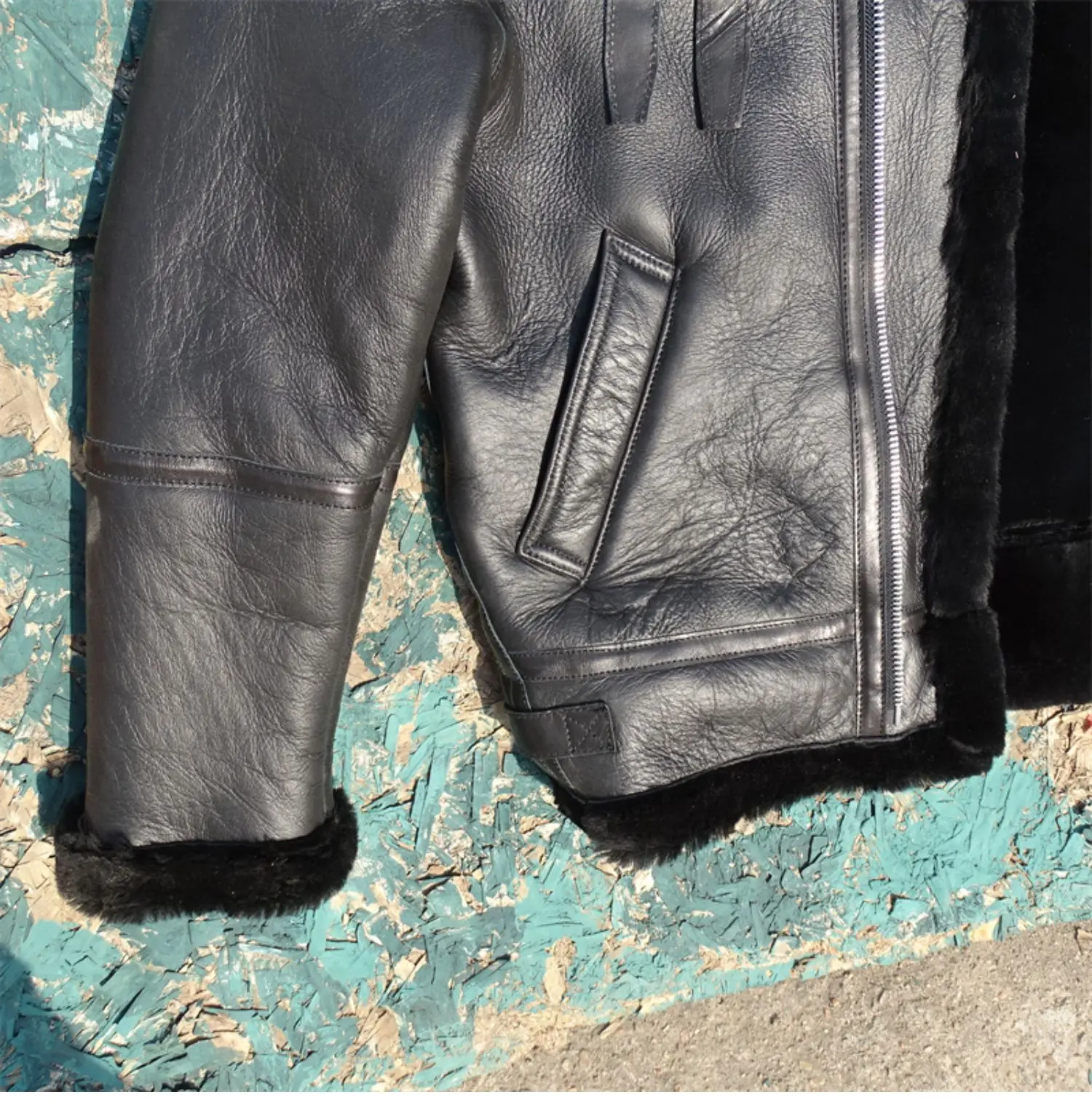
After examining wool’s properties, construction factors, and performance comparisons, we can confidently answer the original question: Yes, a wool coat will keep you warm in winter—and it does so with distinctive advantages over many alternatives.
Wool’s natural fiber structure creates exceptional insulation by trapping body heat in thousands of tiny air pockets. Its remarkable ability to wick moisture while maintaining warmth even when damp makes it uniquely suited to winter conditions. Few materials can match wool’s combination of breathability, insulation, and natural temperature regulation.
Wool coats excel particularly in these winter scenarios:
* Everyday urban wear in temperatures above 10°F (-12°C)
* Variable conditions where temperatures fluctuate throughout the day
* Situations requiring both professional appearance and practical warmth
* Environments with light precipitation or damp conditions
For extreme conditions below 0°F (-18°C) or during stationary outdoor activities in severe cold, wool coats may need supplementation with specialized layers or technical outerwear.
The investment value of a quality wool coat deserves emphasis. While synthetic alternatives may offer lower initial costs, a well-constructed wool coat can provide 5-10 years of reliable winter warmth with proper care—making it economically competitive over its lifetime while offering superior comfort and classic style.
Whether you choose 100% wool or a high-quality blend depends on your specific priorities regarding maintenance, durability, and performance needs. Either way, a properly selected wool coat represents one of winter’s most trusted warming solutions—a reputation earned through centuries of reliable performance in challenging conditions.


